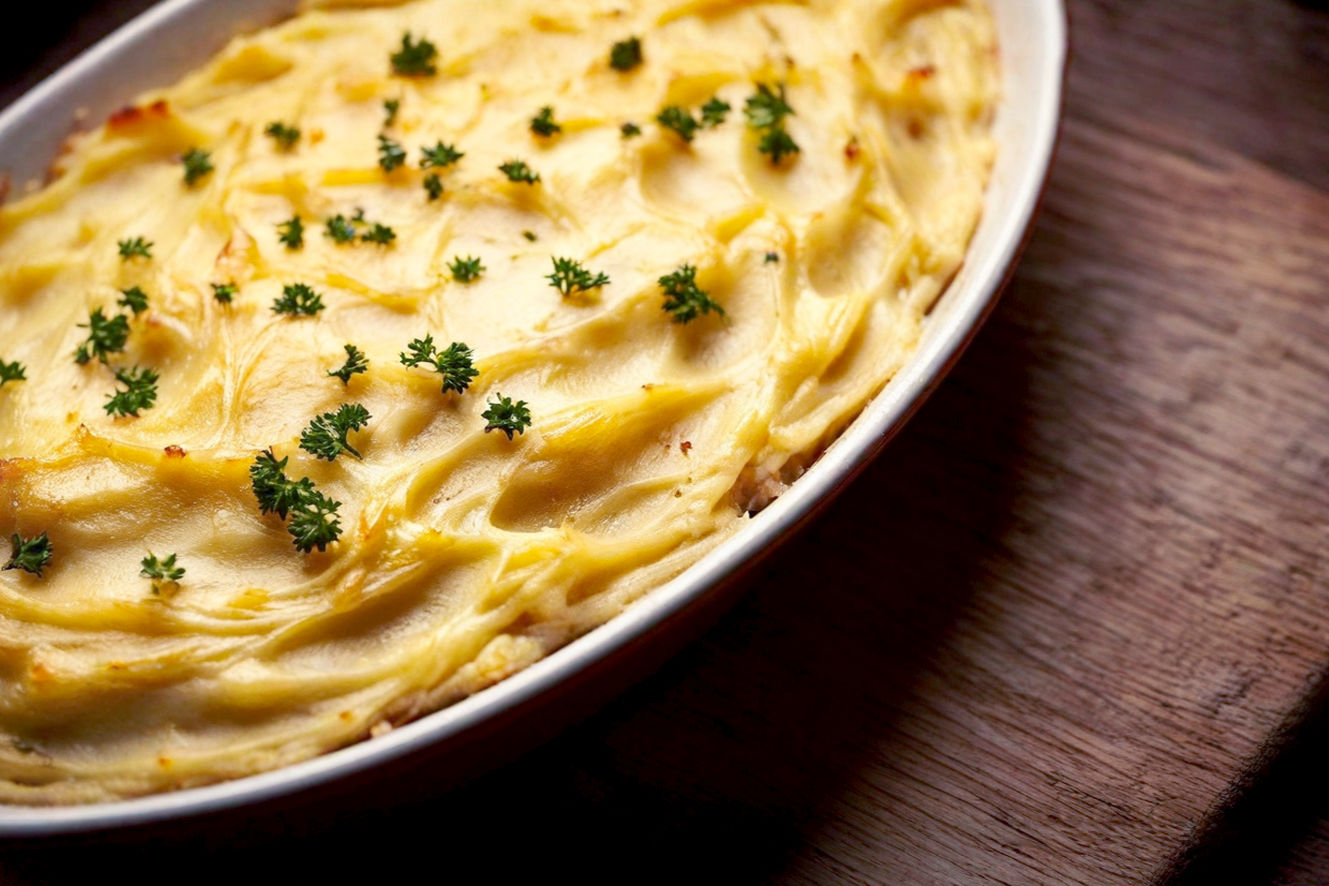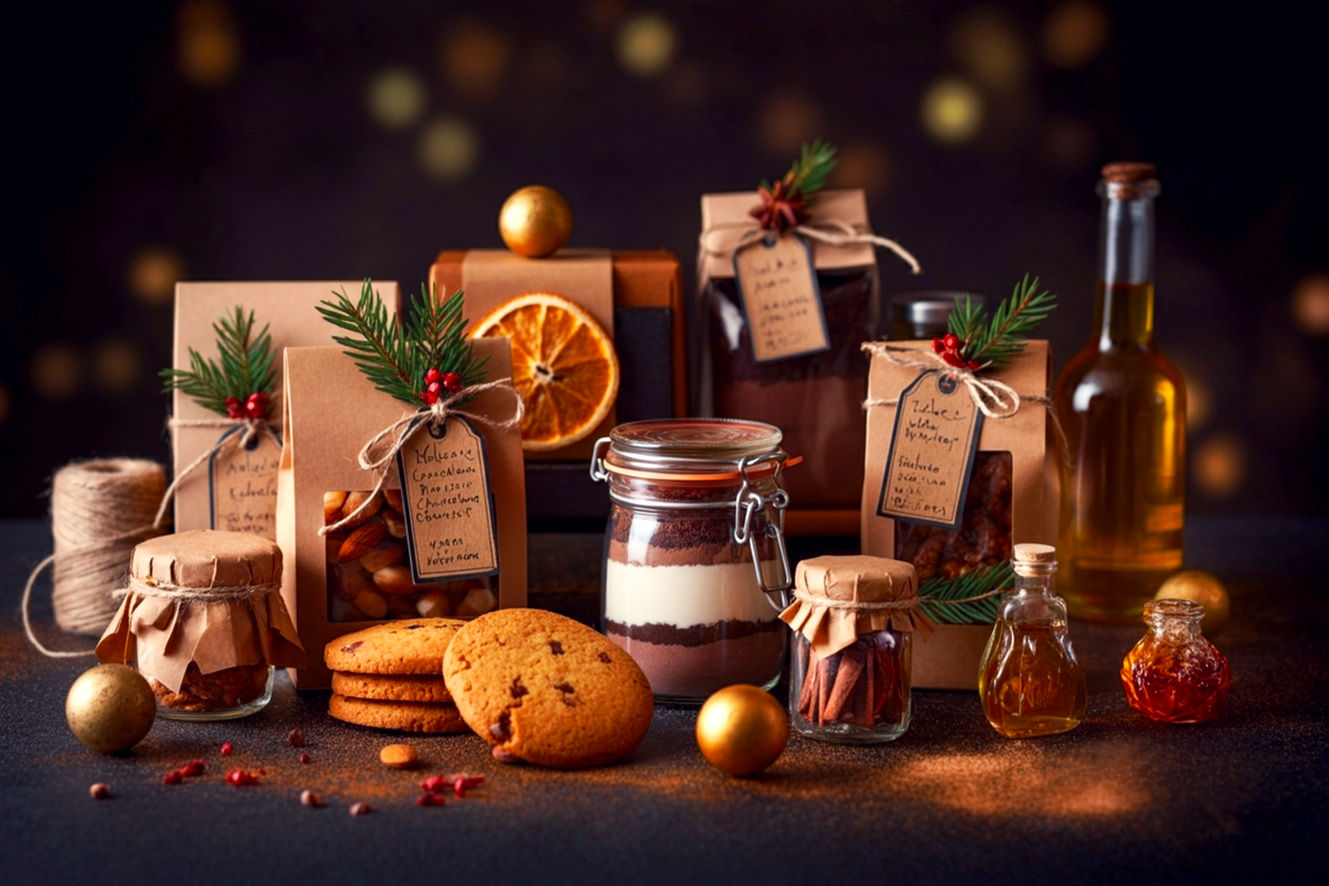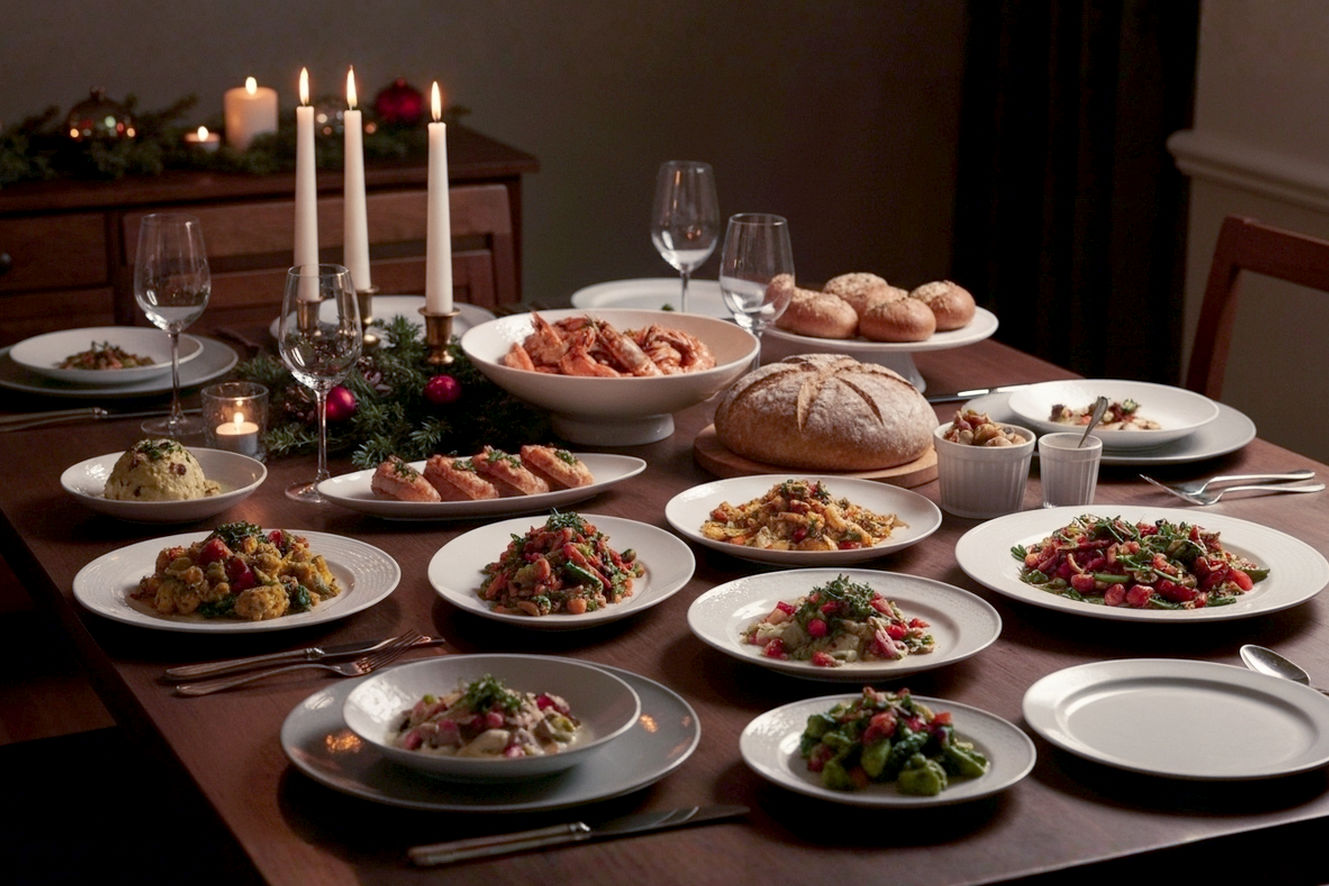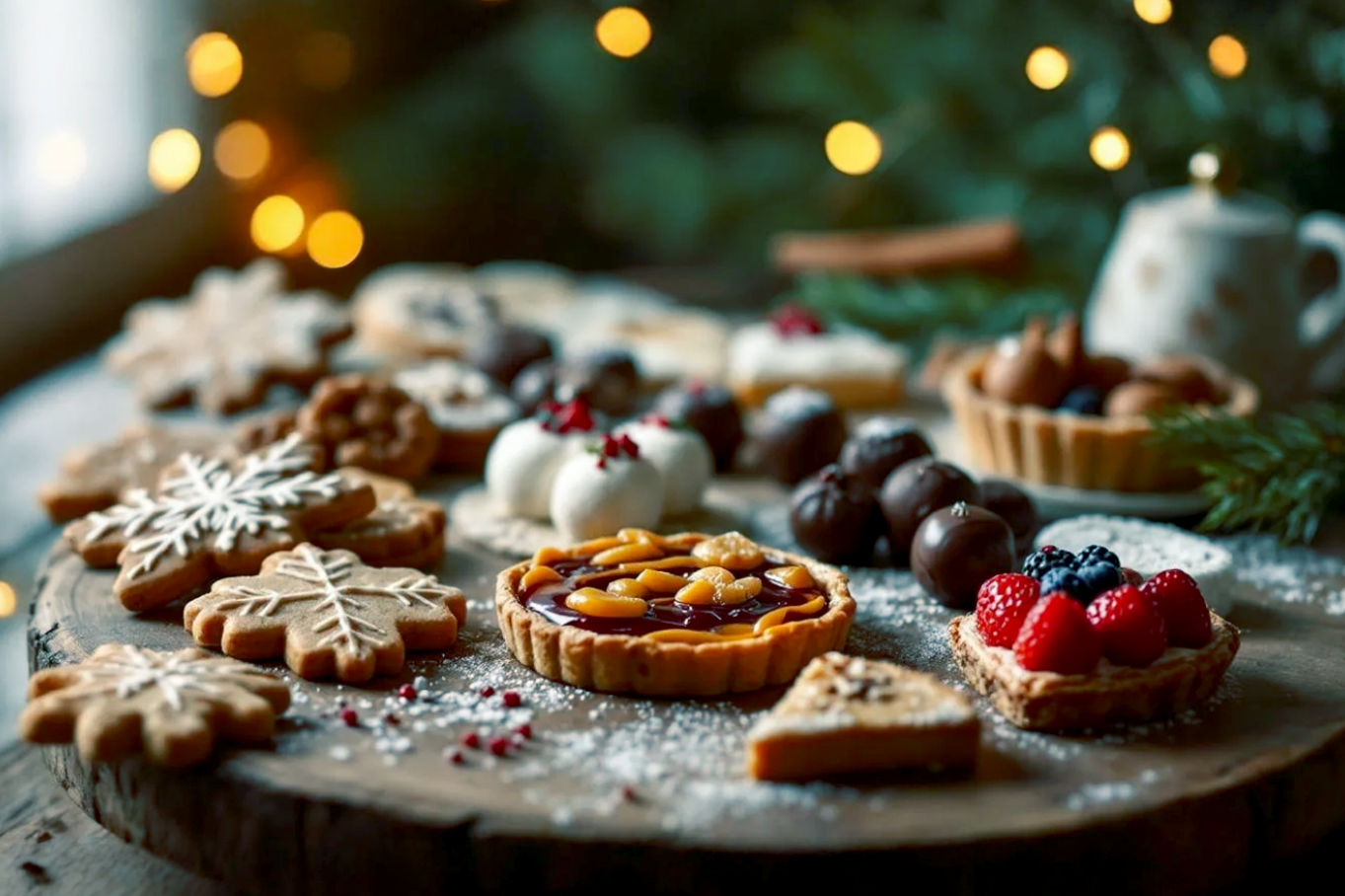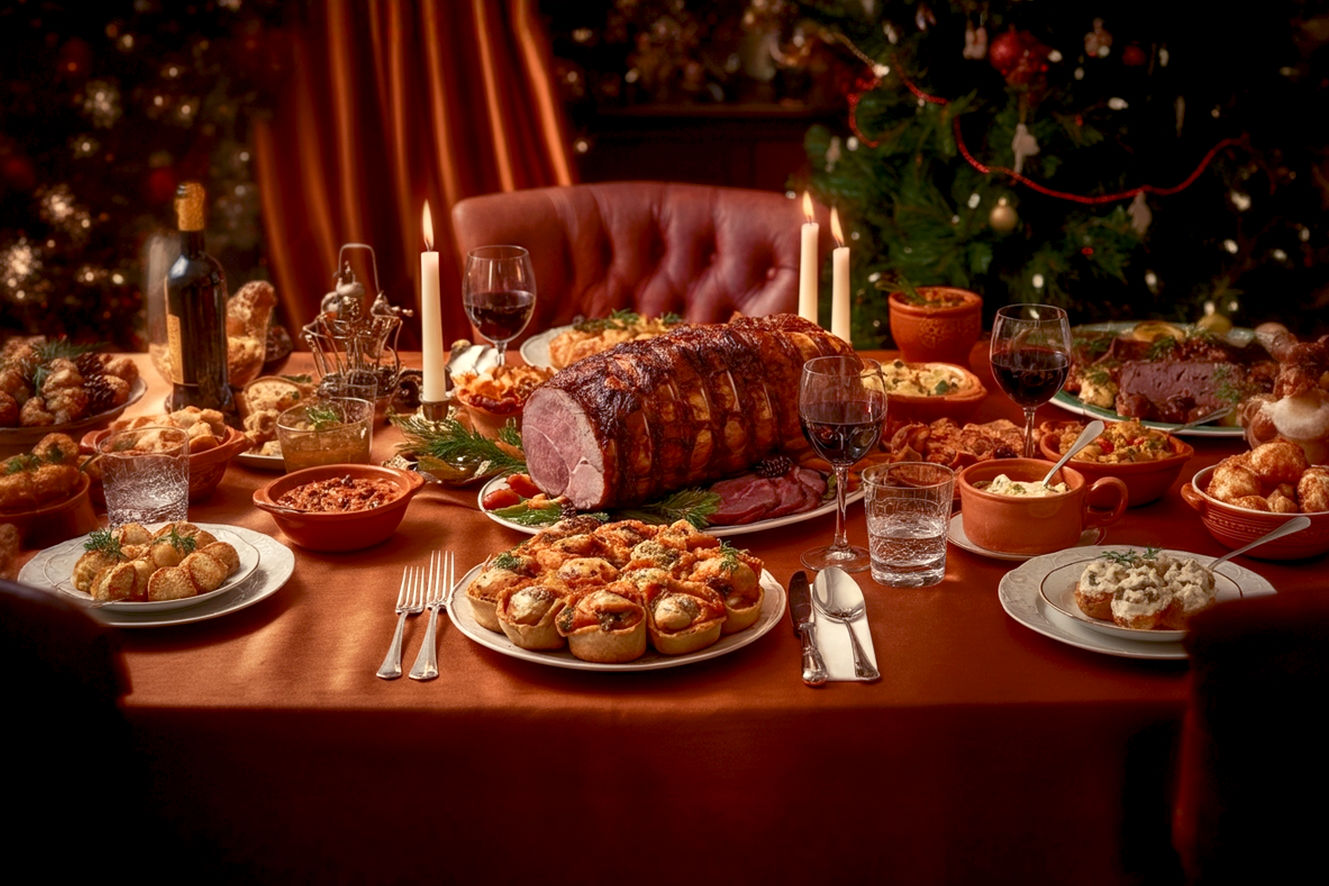This post may contain affiliate links. If you make a purchase through these links, we may earn a commission at no additional cost to you.
The holiday season is a time for warmth, joy, and, of course, delicious food. While traditional roasts and cookies often take center stage, there’s another versatile dish that deserves a spot on your festive table: quiche. This elegant savory tart, with its rich, creamy custard and flaky crust, isn’t just for brunch anymore. It offers an incredible canvas for holiday flavors, allowing you to go beyond basic and create something truly special for Christmas.
Imagine a stunning quiche, bursting with the tastes and colors of the season, serving as a delightful centerpiece for your Christmas morning brunch, a light yet satisfying Christmas Eve dinner, or even a sophisticated appetizer. This article will guide you through transforming this humble dish into a holiday showstopper. We’ll explore unique flavor combinations, show you how to master presentation, and share smart make-ahead strategies that will help you reduce holiday stress. Get ready to elevate your holiday table with creative Christmas quiche ideas!
The Foundation of Festive Quiche: Mastering the Basics
Before we dive into the exciting world of creative fillings, it’s essential to understand the core elements that make a quiche truly great. Think of these as the building blocks for your festive masterpiece.
Understanding Quiche: More Than Just Eggs and Cream
At its heart, a quiche is a savory custard tart. It’s made by pouring a mixture of eggs, cream (or milk), cheese, and various fillings into a pastry crust, then baking it until the custard is set and golden brown. While it sounds simple, the magic lies in the balance of textures and flavors.
Quiche is incredibly versatile, which is why it’s perfect for holiday entertaining. You can customize it with almost any ingredient, making it suitable for different dietary preferences or using up festive leftovers. It’s also a fantastic make-ahead option, meaning you can prepare much of it in advance, freeing up precious time on busy Christmas mornings or before a holiday gathering. Plus, a well-made quiche looks impressive and can easily serve a crowd, making it a practical and elegant choice for your celebrations.
Crust Considerations: From Flaky Traditional to Gluten-Free Wonders
The crust is the foundation of your quiche, providing both structure and flavor. A good crust should be flaky, tender, and sturdy enough to hold the rich filling without becoming soggy.
Classic All-Butter Crust: The Gold Standard
For many, the classic all-butter pastry crust is the ultimate choice. It delivers an unparalleled flaky texture and rich, buttery flavor. The key to success here is using very cold butter cut into small pieces and handling the dough as little as possible. Overworking the dough develops gluten, which can make your crust tough.
A crucial step for preventing a soggy bottom (a common quiche woe) is blind baking. This means partially baking the crust before adding the filling. To do this, line your chilled pie crust with parchment paper and fill it with pie weights, dried beans, or rice. Bake it until the edges are lightly golden, then remove the weights and parchment. For extra protection against sogginess, you can brush the warm, blind-baked crust with a beaten egg wash before filling and baking again. This creates a seal that helps prevent the custard from soaking into the dough. Proper chilling of the dough before baking also helps maintain its shape and flakiness.
Puff Pastry Perfection: Easy Elegance
If you’re short on time or prefer a lighter, airier crust, store-bought puff pastry is an excellent choice. It bakes up incredibly flaky and golden, adding a sophisticated touch with minimal effort. Simply thaw it, gently roll it out (if needed), and fit it into your pie dish. You’ll still want to blind bake it partially to ensure it’s cooked through and to prevent it from becoming too soft under the custard. Tips for handling puff pastry include working quickly as it warms up fast, and pricking the bottom with a fork to prevent excessive puffing during blind baking.
Healthier & Alternative Crusts: Catering to All
For those with dietary restrictions or who prefer lighter options, there are fantastic alternative crusts available. Gluten-free options often use blends of almond flour, rice flour, or a commercial gluten-free all-purpose flour blend. These can be just as delicious and flaky as traditional crusts, though they might require slight adjustments in handling.
You can also explore vegetable-based crusts, which add nutrients and unique flavors. Think about a crust made from grated sweet potato or cauliflower, mixed with a binder like egg and a bit of cheese. These are often crustless quiches, or “frittata-style,” baked directly in a greased pie dish without any traditional pastry. This approach simplifies the process and reduces carbohydrates, offering a lighter alternative that still delivers on flavor.
The Custard Conundrum: Ratios for Richness and Stability
The custard is the heart of your quiche, providing that signature creamy texture. Getting the ratio of eggs to dairy right is crucial for a perfectly set, yet tender, filling.
A good standard ratio is two large eggs per cup of dairy. This provides enough protein to set the custard firmly without making it rubbery. When it comes to dairy choices, you have options that impact the richness and texture. Heavy cream will yield the richest, most luxurious custard. Half-and-half offers a good balance of richness and lightness. Using whole milk will result in a lighter, more delicate custard. You can also mix and match, for example, using a combination of heavy cream and milk. The fat content in the dairy is what contributes to the custard’s silky texture.
Seasoning the custard is essential. Beyond just salt and pepper, a pinch of freshly grated nutmeg is a classic and highly recommended addition; it subtly enhances the savory flavors without being overpowering. Other spices or herbs can be added depending on your chosen fillings.
To achieve the perfect set and avoid cracks on the surface, bake your quiche gently in a moderately heated oven. Overbaking or baking at too high a temperature can cause the custard to puff up too much and then crack as it cools. The quiche is done when the edges are set and slightly puffed, but the center still has a slight jiggle when gently shaken. It will continue to set as it cools.
Savory Sensations: Innovative Christmas Quiche Fillings
Now for the fun part: infusing your quiche with festive, savory flavors that go beyond the everyday. These ideas combine classic holiday ingredients with unexpected twists to create memorable dishes.
Traditional Flavors, Elevated
Let’s start with familiar holiday tastes and see how we can transform them into exciting quiche fillings.
Roast Turkey & Cranberry Quiche: A Leftover Revival
This quiche is a fantastic way to utilize leftover roast turkey from your Christmas dinner. Instead of just a sandwich, imagine it nestled in a creamy custard with the bright, tart notes of cranberries. To make this, dice your cooked turkey and combine it with dried cranberries, which offer a concentrated sweetness and chewiness. Add fresh sage, a quintessential holiday herb, and nutty Gruyère cheese for its excellent melting properties and savory depth. For an extra layer of festive flavor, consider adding a hint of orange zest to the custard; the citrus brightens the entire dish and pairs beautifully with both turkey and cranberry. This quiche transforms leftovers into a gourmet meal.
Ham & Gruyère with Caramelized Onion: Sweet and Smoky Harmony
The combination of smoky ham and sweet caramelized onions is a match made in heaven, and it shines in a quiche. The sweetness of caramelized onions takes time to develop, but it’s well worth the effort. Slowly cook sliced onions until they are deeply golden and soft, bringing out their natural sugars. Pair these with diced, smoky ham (leftover holiday ham works perfectly) and plenty of nutty Gruyère cheese. For an aromatic touch, a sprinkle of fresh thyme or rosemary complements these flavors beautifully, adding an earthy, herbaceous note that screams “holiday.”
Smoked Salmon & Dill with Cream Cheese Swirl: Luxurious Brunch
For a truly elegant and luxurious quiche, consider smoked salmon and dill. This combination evokes a sophisticated brunch or appetizer. Layer delicate flakes of smoked salmon (lox or hot-smoked salmon both work well) with plenty of fresh dill and finely chopped chives. What makes this quiche truly special is a cream cheese swirl. After pouring the custard into the crust, dollop small spoonfuls of softened cream cheese over the top and gently swirl them in with a knife. As it bakes, the cream cheese melts into pockets of tangy, creamy goodness, adding an extra layer of richness and a delightful tang that perfectly balances the salmon.
Vegetarian & Plant-Forward Festivities
Christmas quiches don’t have to be meat-centric. These vegetarian options are vibrant, flavorful, and will impress even the most devoted carnivores.
Roasted Butternut Squash & Sage Quiche with Goat Cheese: Autumnal Sweetness
This quiche celebrates the sweet, earthy flavors of autumn and winter vegetables. Start by roasting butternut squash cubes until they are tender and slightly caramelized; this brings out their natural sweetness. Combine the roasted squash with fragrant fresh sage leaves and dollops of tangy goat cheese. The goat cheese melts into creamy pockets, providing a lovely counterpoint to the squash. For added texture and a nutty flavor, you could also sprinkle in some toasted pecans before baking. This combination offers a beautiful balance of sweet, savory, and tangy notes.
Mushroom & Leek Quiche with Thyme: Earthy Elegance
Mushrooms and leeks are a classic pairing, offering deep, earthy flavors that are perfect for a cozy holiday meal. Sauté a mix of earthy mushrooms (cremini, shiitake, or even wild mushrooms for a gourmet touch) until they are golden brown and their moisture has evaporated. Separately, gently sauté thinly sliced leeks until they are sweet and tender. Combine these with plenty of fresh thyme and a generous amount of grated Parmesan cheese, which adds a salty, umami kick. This quiche is rich in flavor and has a wonderfully comforting aroma.
Spinach, Feta & Sun-Dried Tomato Quiche: Mediterranean Flair
While spinach and feta is a classic quiche combination, adding sun-dried tomatoes gives it a vibrant, concentrated flavor and a beautiful pop of color, making it more festive. Sauté fresh spinach until wilted, then squeeze out all excess water to prevent a watery quiche. Crumble in feta cheese for its salty tang, and chop oil-packed sun-dried tomatoes for their intense, sweet-tart flavor. These ingredients create a Mediterranean-inspired quiche that’s both fresh and satisfying. For an extra briny note, consider adding a few chopped Kalamata olives.
Bold & Unexpected Combinations
Don’t be afraid to experiment! These quiche ideas push the boundaries, combining ingredients in surprising ways that are sure to delight your guests.
Bacon, Brussels Sprouts & Maple Quiche: Sweet, Salty, and Savory
This combination might sound unusual, but it’s incredibly delicious. The key is to roast or pan-fry the Brussels sprouts until they are tender and slightly charred, which mellows their natural bitterness and brings out a subtle sweetness. Pair them with crispy, salty bacon pieces. What ties it all together is a hint of maple syrup drizzled into the custard or over the sprouts before baking. This touch of sweetness perfectly complements the savory bacon and the slightly bitter sprouts. Use a sharp cheddar or white cheddar cheese for a robust flavor that stands up to the other ingredients.
Pear, Prosciutto & Gorgonzola Quiche: A Sophisticated Medley
For a truly gourmet and sophisticated quiche, try the elegant combination of pear, prosciutto, and Gorgonzola. The sweetness of thinly sliced pears (such as Bosc or Anjou) provides a beautiful contrast to the salty, savory prosciutto. The star of the show, however, is the pungent, creamy Gorgonzola cheese, which adds a bold, complex flavor. A light drizzle of honey over the top before baking can further enhance the sweet and savory balance. This quiche is a sophisticated appetizer or a unique main course for a festive gathering.
Spiced Apple & Cheddar Quiche: Unexpected Harmony
This combination might raise eyebrows, but it’s a surprisingly delicious pairing that’s popular in some culinary traditions. The tartness of Granny Smith apples is a fantastic foil for the sharp, savory notes of cheddar cheese. Dice the apples and sauté them lightly with a blend of warm spices like cinnamon, nutmeg, and a pinch of allspice. This infuses the apples with a comforting, festive aroma. Layer these spiced apples with grated sharp cheddar cheese in your crust, then pour over the custard. The result is a unique sweet and savory quiche that’s perfect for a holiday brunch or even a light dessert.
Sweet Surprises: Dessert Quiches for Christmas
Who says quiche has to be savory? Dessert quiches offer a delightful and unexpected twist, perfect for a festive sweet treat. They follow the same basic structure but swap savory fillings for sweet ones, creating a rich, custardy dessert.
Cranberry Orange & White Chocolate Quiche: Bright and Indulgent
This dessert quiche captures the bright, festive flavors of the season. The tartness of fresh or frozen cranberries provides a wonderful contrast to the sweetness of the custard and white chocolate chunks. Infuse your custard with plenty of orange zest for a bright, citrusy aroma that pairs beautifully with cranberries. As the quiche bakes, the white chocolate melts into sweet, creamy pockets, creating a truly indulgent experience. This quiche is visually appealing with the vibrant red cranberries and tastes like Christmas in every bite.
Gingerbread Spice Quiche: Warm and Comforting
Embrace the cozy spices of gingerbread in a dessert quiche. The custard is infused with a blend of warm spices like ground ginger, cinnamon, cloves, and a touch of nutmeg. A spoonful of molasses adds the characteristic deep, slightly smoky sweetness and rich color associated with gingerbread. For an extra textural element and burst of flavor, you can also fold in small pieces of candied ginger. This quiche is incredibly aromatic and comforting, perfect for a cold winter’s day.
Chocolate Peppermint Quiche: Festive and Decadent
For chocolate lovers, this quiche is a dream come true. A rich, dark chocolate custard forms the base, made with cocoa powder and melted chocolate. After pouring the custard into the crust, sprinkle generously with crushed peppermint candies or candy canes. As it bakes, the peppermint melts slightly, infusing the chocolate with its refreshing flavor. Serve this decadent quiche chilled, garnished with a swirl of whipped cream and a few more crushed peppermint pieces for a stunning presentation. It’s a festive and truly indulgent dessert.
Presentation Perfection: Making Your Quiche a Holiday Showstopper
A delicious quiche is even better when it looks as good as it tastes. With a few simple techniques, you can transform your Christmas quiche into a true holiday showstopper.
Decorative Crust Edges: Adding Flair
The edge of your quiche crust offers a prime opportunity for decoration. Instead of just pressing it down, try different crimping techniques. A simple fork can create a lovely pattern around the rim. For a more classic look, you can use your fingers to flute the edges, creating a beautiful wavy pattern. If you have leftover pastry dough, use small cookie cutters to create festive cut-out shapes like stars, trees, or snowflakes. You can then gently press these onto the rim of the quiche before baking. For a beautiful golden sheen, brush the crust with an egg wash (a beaten egg mixed with a tablespoon of water) before baking. This gives it a professional, glossy finish.
Garnishing for Glamour: The Finishing Touch
Once your quiche is baked and cooled slightly, garnishing is the final step to elevate its appearance. Choose garnishes that complement the flavors within. For savory quiches, fresh rosemary sprigs or small bundles of thyme can add an aromatic and visually appealing touch. Bright red cranberries, either fresh or sugared, provide a pop of festive color. You can also sprinkle on some delicate cheese shavings (like Parmesan or a hard cheddar) or toasted nuts (pecans, walnuts) for added texture and visual interest. For sweet quiches, a dusting of powdered sugar, a dollop of whipped cream, or a sprinkle of cinnamon can make a big difference. If appropriate for the flavor profile, small edible flowers can also add an unexpected touch of elegance.
Serving Suggestions & Accompaniments: Completing the Meal
Consider what you’ll serve alongside your Christmas quiche to complete the meal. For savory quiches, a light, crisp green salad with a simple vinaigrette provides a refreshing contrast to the richness of the quiche. A beautiful fresh fruit platter adds color and a healthy element, especially for brunch. If serving for breakfast or brunch, crispy bacon or sausage can be a welcome addition. For beverages, warm spiced cider or festive mimosas (orange juice and sparkling wine) are perfect for a holiday gathering. For dessert quiches, a scoop of vanilla ice cream or a dollop of crème fraîche can be delightful.
Practical Pointers: Make-Ahead, Storage, and Reheating
One of the greatest advantages of quiche, especially during the busy holiday season, is its make-ahead potential. Knowing how to properly prepare, store, and reheat your quiche can save you a lot of stress.
The Beauty of Make-Ahead Quiche: Stress Reduction
Preparing quiche in advance is a game-changer for holiday entertaining. You have a few options:
- Fully Bake Ahead: You can bake your quiche completely, allow it to cool thoroughly at room temperature, and then refrigerate it. This is ideal for serving within 1-2 days. Simply cover it tightly with plastic wrap once cooled.
- Freezing Baked Quiche: For longer storage, you can freeze a fully baked quiche. Once completely cooled, wrap it tightly in several layers of plastic wrap and then aluminum foil. It can be frozen for up to 1-2 months. Thaw overnight in the refrigerator before reheating.
- Freezing Unbaked Quiche: You can even prepare an unbaked quiche and freeze it. Assemble the quiche (crust, filling, mix-ins), then wrap it very tightly. When ready to bake, place the frozen quiche directly into a preheated oven, adding extra baking time (often 15-30 minutes) and covering the edges with foil if they brown too quickly. This method is great for maximum freshness upon serving.
The benefits for holiday stress reduction are immense. Having a delicious, ready-to-go dish means less last-minute cooking, allowing you to enjoy your guests and the festivities more.
Storage Savvy: Keeping it Fresh
Proper storage ensures your quiche remains delicious and safe to eat. Once baked, quiche should be refrigerated within two hours of cooling. Store it in an airtight container or tightly wrapped with plastic wrap in the refrigerator for up to 3-4 days. This prevents it from drying out or absorbing other odors from your fridge.
Reheating Right: Maintaining Texture
The way you reheat quiche can significantly impact its texture.
- Oven Reheating for Best Texture: For the best results, especially if you want a crispy crust, oven reheating is preferred. Preheat your oven to a moderate temperature (around 300-325°F or 150-160°C). Place the quiche (or individual slices) on a baking sheet and heat for 15-25 minutes, or until warmed through. This low and slow method helps the crust crisp up again and prevents the custard from becoming rubbery.
- Microwave for Speed: While quicker, microwaving can sometimes alter the texture of the custard, making it less creamy and potentially rubbery. If using a microwave, heat individual slices on a microwave-safe plate in short bursts (30-60 seconds) until warmed through. It’s best for a quick bite, but the oven is superior for overall quality.
Aim to serve quiche warm or at room temperature, depending on your preference and the specific recipe.
Troubleshooting Common Quiche Problems: Solutions for Success
Even experienced cooks encounter quiche challenges. Here are solutions to common problems:
- Soggy Bottom: This is the most frequent complaint. The primary solution is blind baking your crust thoroughly before adding the filling. Ensure your oven is hot enough (often 375-400°F for the initial blind bake) and consider brushing the partially baked crust with an egg wash to create a barrier. A hot oven also helps the crust cook quickly before the custard has a chance to soak in.
- Cracked Top: A cracked quiche top usually indicates overbaking or baking at too high a heat. When the custard cooks too quickly or for too long, it expands excessively and then contracts rapidly as it cools, leading to cracks. Bake at a moderate temperature (around 350-375°F or 175-190°C) and remove the quiche from the oven when the edges are set but the center still has a slight wobble. It will continue to set as it cools.
- Runny Center: If your quiche has a runny center, it’s simply underbaked. Return it to the oven and continue baking until the center is mostly set. Use the “slight jiggle” test: the center should jiggle like firm gelatin, not liquid. If the crust is browning too much, loosely tent the quiche with aluminum foil. Not enough eggs in the custard ratio can also contribute to a runny center, so double-check your recipe’s egg-to-dairy proportions.
Beyond the Recipe: Customizing Your Christmas Quiche
The beauty of quiche lies in its adaptability. Once you understand the basic principles, you can easily customize recipes to suit your taste, available ingredients, or dietary needs.
Ingredient Swaps & Substitutions: Your Kitchen, Your Rules
Feel free to get creative with your fillings!
- Cheese Varieties: Experiment with different cheeses. Instead of Gruyère, try sharp cheddar, Swiss, provolone, Monterey Jack, or even a blend of Italian cheeses. The type of cheese will significantly impact the flavor profile.
- Vegetable Alternatives: Swap out vegetables based on what’s in season or what you have on hand. Broccoli, asparagus, bell peppers, zucchini, or roasted root vegetables can all work wonderfully. Just be sure to pre-cook any vegetables that release a lot of water (like mushrooms or spinach) and squeeze out excess moisture.
- Meat/Protein Options: Beyond ham and turkey, consider cooked chicken, crumbled sausage, crispy pancetta, or even flaked smoked trout. For plant-based proteins, try crumbled firm tofu (seasoned well), lentils, or a hearty bean mixture.
- Dairy Alternatives: For those with lactose intolerance or who prefer plant-based options, many dairy alternatives work well in quiche custard. Unsweetened almond milk, soy milk, or oat milk can be used, though the texture might be slightly less rich than with heavy cream. Ensure they are unsweetened and unflavored. Vegan cheeses can also be used in place of dairy cheese.
Scaling Up or Down: Adapting to Your Needs
Quiche recipes are generally flexible when it comes to size.
- Adjusting for Different Pan Sizes: Most recipes are written for a standard 9-inch pie dish. If you’re using a larger (e.g., 10-inch) or smaller (e.g., 8-inch) dish, you’ll need to adjust the amount of filling accordingly. A 10-inch quiche might need an extra egg and about 1/2 cup more dairy. For smaller dishes, reduce the quantities. Baking times will also vary.
- Mini Quiches for Appetizers: For a party, mini quiches are a fantastic idea. Use a mini muffin tin or a tartlet pan. Simply cut your pastry into small rounds, press them into the cups, fill, and bake. Mini quiches bake much faster (typically 15-25 minutes) and are perfect for individual servings, making them ideal as an elegant holiday appetizer.
Dietary Adaptations: Inclusive Holiday Feasting
Making small adjustments can ensure everyone at your Christmas gathering can enjoy your quiche.
- Gluten-Free Considerations: As mentioned, using a gluten-free crust is the primary step. When preparing, be mindful of cross-contamination if you’re also handling gluten-containing ingredients in the same kitchen. Ensure all utensils and surfaces are clean.
- Dairy-Free Options: For dairy-free quiches, use unsweetened plant-based milks (almond, soy, oat) for the custard. You can also find good quality vegan cheeses that melt well. Nutritional yeast can add a cheesy flavor without dairy.
- Low-Carb Variations: The easiest way to make a quiche low-carb is to make it crustless. Simply pour the filling directly into a greased pie dish. You can also use vegetable-based crusts, as discussed earlier. Focus on low-carb fillings like spinach, mushrooms, peppers, and various meats.
Conclusion: Your Christmas Quiche Masterpiece Awaits
As you can see, quiche is far more than just a simple egg tart. It’s an incredibly versatile and elegant dish that holds immense potential for creative expression, especially during the festive Christmas season. By understanding the fundamentals of crust and custard, and then daring to experiment with a myriad of savory and even sweet fillings, you can transform this classic into a true holiday masterpiece.
We’ve explored everything from traditional flavors elevated with a festive twist, to vibrant vegetarian options, and even bold, unexpected combinations that will surprise and delight your guests. Remember the importance of presentation – a beautifully crimped crust or a thoughtful garnish can turn a delicious quiche into a stunning showstopper. And don’t forget the practical magic of make-ahead preparation, allowing you to savor the holiday moments without last-minute kitchen stress.
So, this Christmas, don’t just make a quiche; create a culinary experience. Embrace the spirit of experimentation, mix and match your favorite holiday flavors, and let your creativity shine. Your Christmas quiche masterpiece awaits, ready to add a touch of warmth, flavor, and elegance to your festive feast. Happy holidays and happy baking!

